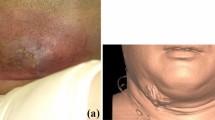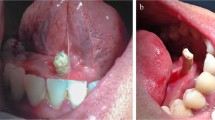Abstract
Over 80% of sialoliths form in the submandibular glands. Well-recognized complications include blockage or narrowing of salivary ducts leading to pain, edema, and infection. Less commonly, fistulas may develop into the oral cavity and very rarely, sialoliths may migrate to the skin’s surface. Our literature review revealed only five reported cases of migrating sialoliths with two reporting stones migrating down the neck prior to eroding through the skin. An 89-year-old woman with a history of chronic sialolithiasis in the right submandibular gland with a sialolith documented on CT 2 years prior, presented with a rapidly growing skin lesion overlying her right sternocleidomastoid in level three. Repeat CT showed a similar sized sialolith underneath the skin lesion and atrophy of the right submandibular gland. This is a rare case of a sialolith eroding through the submandibular gland, tracking down the neck and through the skin. We propose the mechanism of this complication is that the stone causes inflammation and scarring within the gland obstructing Wharton’s duct leading to increased pressure from salivary back flow. The gland becomes ischemic and the stone is slowly forced through the gland. We believe that the stone then migrates along the investing fascia of the submandibular gland and sternocleidomastoid muscle. This paper is the first to propose a mechanism for this complication and is one of the few cases with pre- and post-migratory imaging. This case helps provide further evidence to support appropriate treatment and follow-up on patients with chronic sialolithiasis.


Similar content being viewed by others
Abbreviations
- SMG:
-
submandibular gland
- SCM:
-
sternocleidomastoid
References
Bailey BJ, Johnson JT, Newlands SD. Head & neck surgery--otolaryngology. Philadelphia: Lippincott Williams & Wilkins; 2006.
Abdullah O, AlQudehy Z. Giant submandibular sialolith: A case report and literature review. Indian J Otol. 2016;22(2):126.
Drage NA, Brown JE, Makdissi J, Townend J. Migrating salivary stones: report of three cases. Br J Oral Maxillofac Surg. Apr. 2005;43(2):180–2.
Seward GR. Anatomic surgery for salivary calculi. VII. Complications of salivary calculi. Oral Surg Oral Med Oral Pathol. 1968;26(2):137–44.
Rauso R, Gherardini G, Biondi P, Tartaro G, Colella G. A case of a giant submandibular gland calculus perforating the floor of the mouth. Ear Nose Throat J. 2012;91(6):E25–7.
Singh S, Singh S. Submandibular gland megalith eroding the floor of the mouth: a case report. Ear Nose Throat J. 2013;92(12):E17–9.
Nemade SV, Rokade VV, Pathak NA, Kashibai S. A giant sialolith with perforation of the floor of mouth. Otolaryngology Online Journal. 2013;3(4).
El Deeb M, Holte N, Gorlin RJ. Submandibular salivary gland sialoliths perforated through the oral floor. Oral Surg Oral Med Oral Pathol. 1981;51(2):134–9. https://doi.org/10.1016/0030-4220(81)90029-3.
Zakaria MA. Giant calculi of the submandibular salivary gland. Br J Oral Surg. 1981;19(3):230–2.
Akin I, Esmer N. A submandibular sialolith of unusual size: a case report. J Otolaryngol. 1991;20(2):123–5.
Asfar SK, Steitiyeh MR, Abdul-Amir R. Giant salivary calculi: an orocervical fistula caused by a submandibular gland calculus. Can J Surg. 1989;32(4):295–6.
Lim EH, Nadarajah S, Mohamad I. Giant submandibular calculus eroding oral cavity mucosa. Oman Med J. 2017;32(5):432–5.
Warden PJ, Adamson DN. Sialolithiasis: literature review and case report. Gen Dent. 43(6):518–20.
Brown K, Cheah T, Ha JF. Spontaneous cutaneous extrusion of a parotid gland sialolith. BMJ Case Rep. 2016;2016:bcr2016214887.
Karengera D, Yousefpour A, Reychler H. Unusual elimination of a salivary calculus. A case report. Int J Oral Maxillofac Surg. 1998;27(3):224–5.
Acknowledgements
We thank the Department of Otolaryngology, Queen’s University for their support in this project.
Data and materials availability
All data was presented in the paper.
Author information
Authors and Affiliations
Contributions
MH conducted the literature review. TP analyzed and interpreted the patient data for the case presentation. MH and TP wrote the manuscript together. All authors read and approved the final manuscript.
Corresponding author
Ethics declarations
Ethics approval and consent to participate
Consent to participate was provided and it may be provided if requested.
Consent for publication
Consent for publication was provided by the patient and it may be provided if requested.
Conflict of interest
The authors declare no competing interests.
Additional information
Publisher’s Note
Springer Nature remains neutral with regard to jurisdictional claims in published maps and institutional affiliations.
This article is part of the Topical Collection on Surgery
Rights and permissions
About this article
Cite this article
Heinelt, M., Phillips, T. The Migrating Sialolith: a Case Report. SN Compr. Clin. Med. 3, 2052–2055 (2021). https://doi.org/10.1007/s42399-021-00953-w
Accepted:
Published:
Issue Date:
DOI: https://doi.org/10.1007/s42399-021-00953-w




